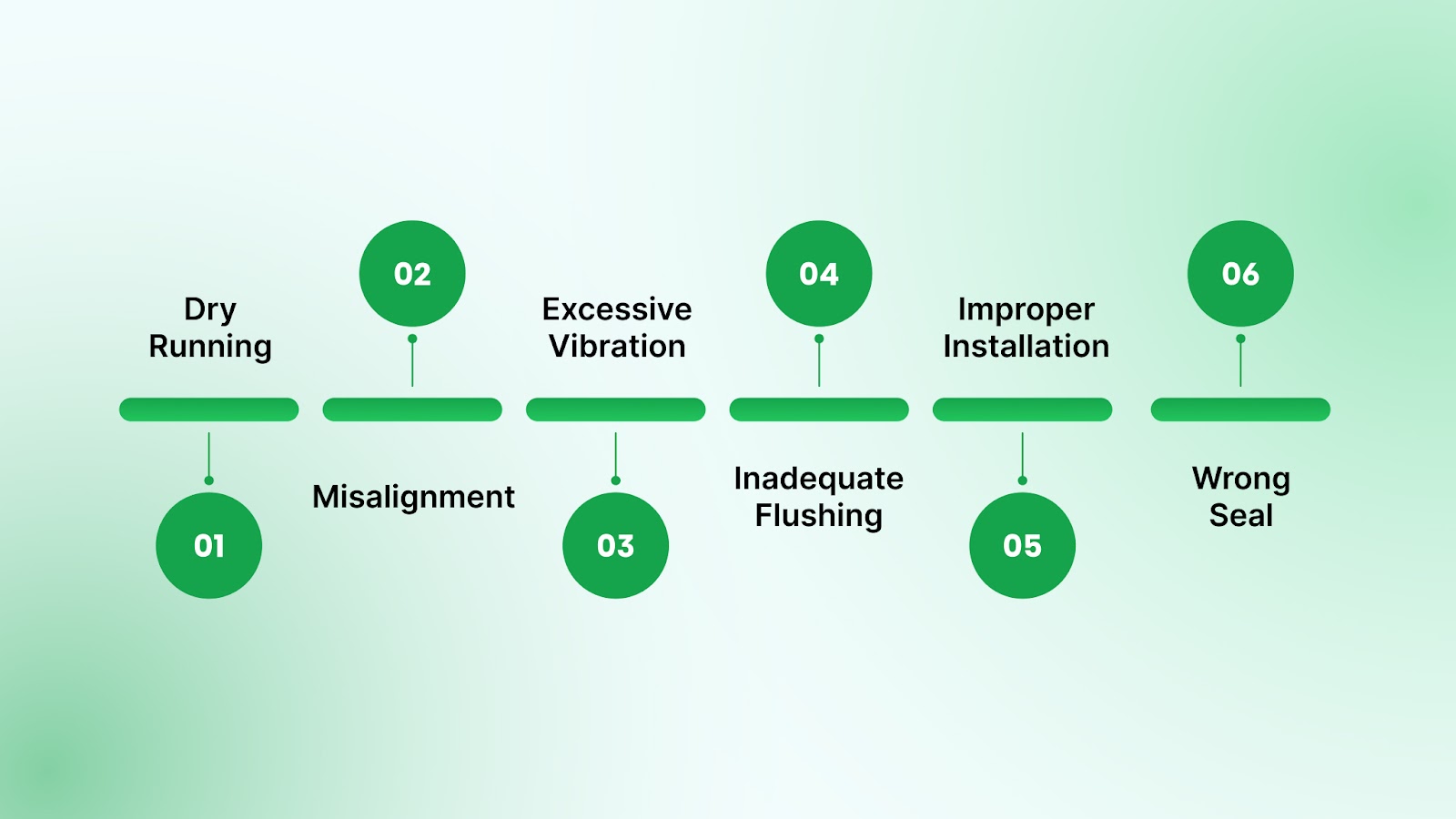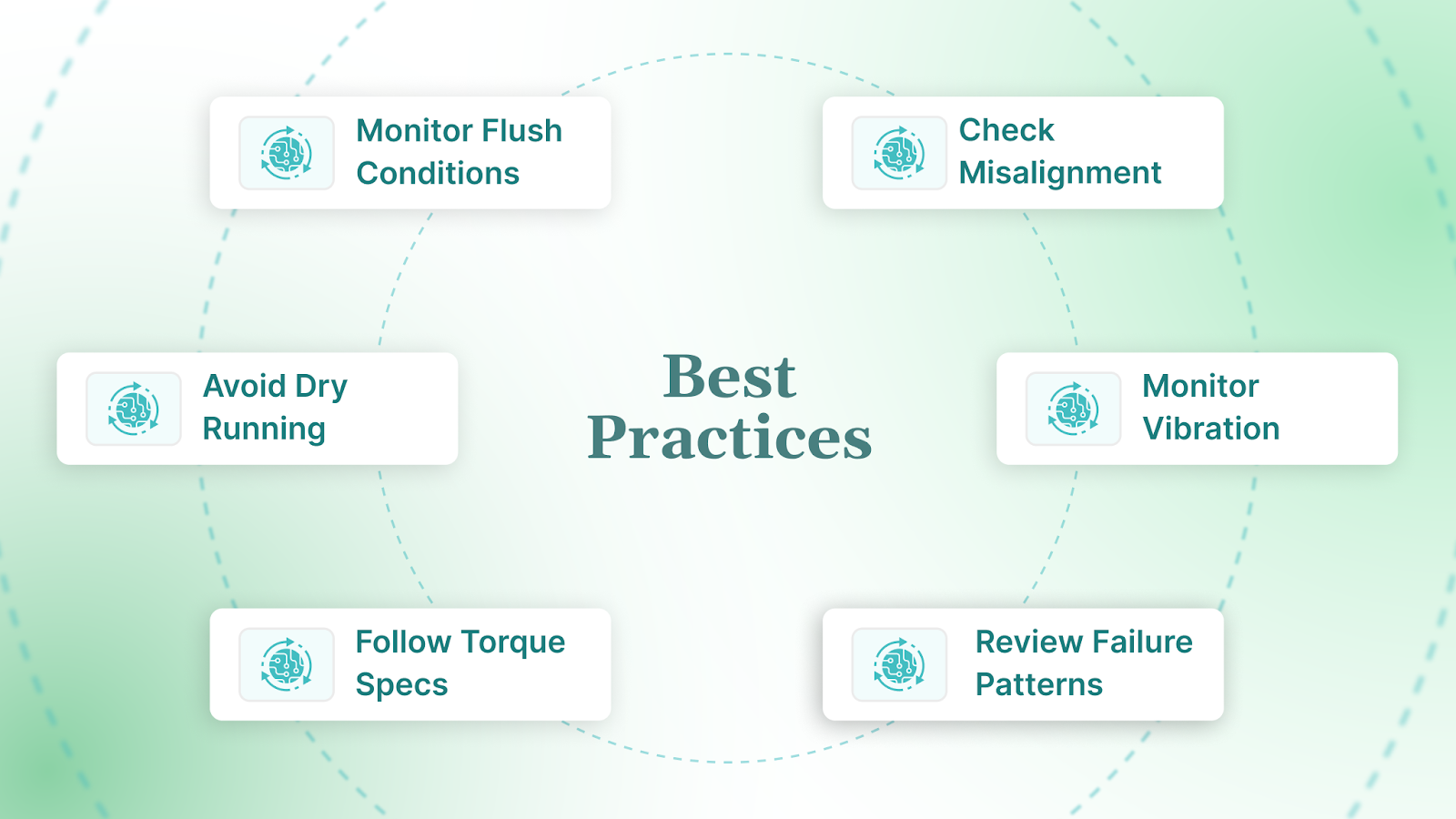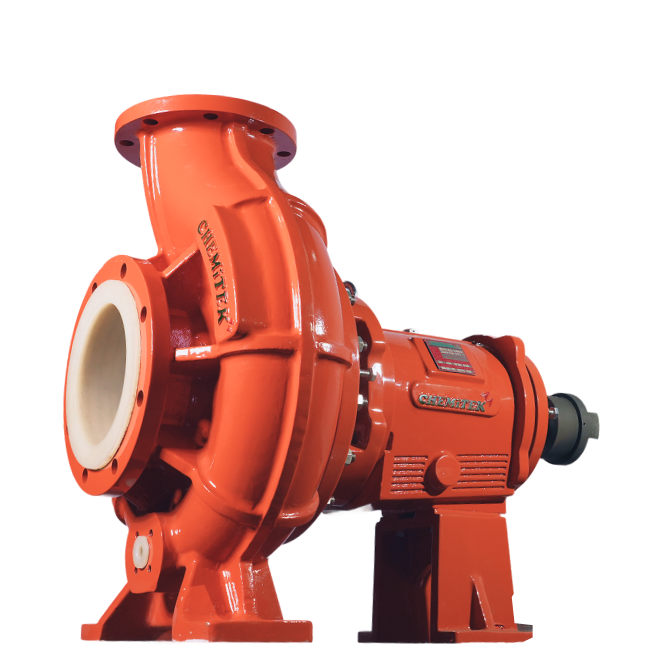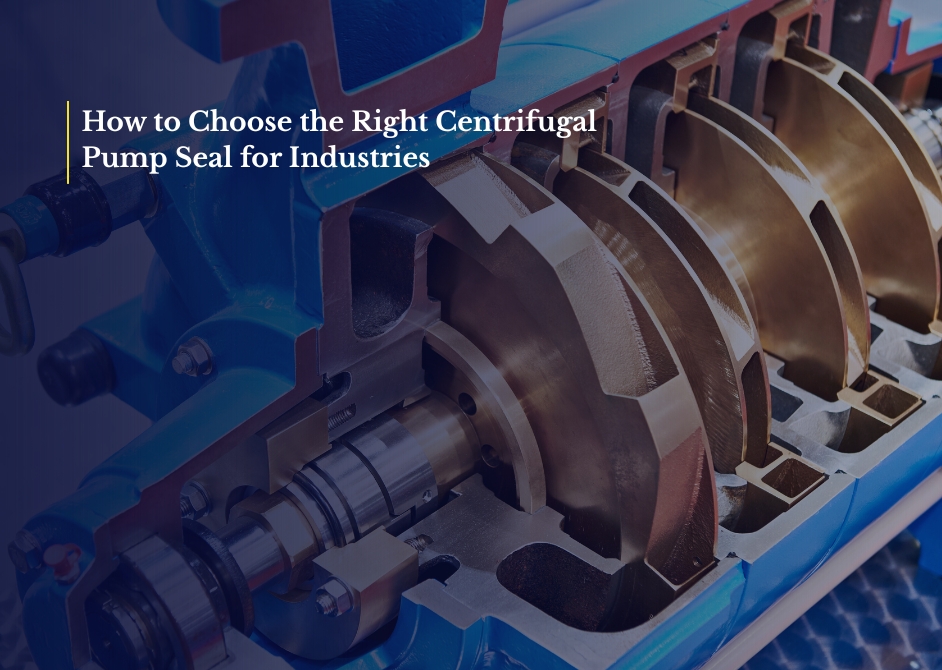If you’re running operations in sugar, chemical, or fertilizer plants, you already know what a seal does. What really matters is how well it performs and how long it can hold up under pressure.
Centrifugal pump seals are exposed to constant flow, high temperatures, corrosive fluids, and abrasive particles. A good seal ensures a smooth and reliable process. A weak one causes leaks, breakdowns, and unplanned stops.
This guide is designed to help you make the right choice. You’ll find simple explanations of different seal types, how to match materials with your process, and what to look for when selecting a seal that lasts so your pumps keep working without surprises.
Key Takeaways
- Seal performance directly affects pump reliability, especially in industries handling high-temperature, corrosive, or abrasive fluids.
- Different seal types (single, double, cartridge, balanced) are suited to different pressures, flow conditions, and fluid types.
- Choosing the right material (carbon, silicon carbide, elastomers) helps extend seal life and prevent chemical or thermal damage.
- Seal failure is preventable when causes like dry running, vibration, or misalignment are addressed early.
- Custom sealing systems like Chemitek’s IMSS/IMSD offer higher reliability for aggressive process conditions and slurry handling up to 30%.
- Smart sealing technologies and durable materials are reshaping the future of centrifugal pump performance, making plants safer, more efficient, and cost-effective.
Why Seal Selection Matters in Centrifugal Pumps
In industrial pumps, not all sealing challenges are the same. A seal that performs well in clean water transfer might fail quickly when exposed to molasses, acidic juice, or abrasive slurry.
That’s why selection isn’t just about the fluid staying in it’s about finding a seal that fits the exact operating environment. For example:
- In sugar processing, seals must handle sugar crystals and fibers without clogging or wearing down the faces.
- In chemical transfer, seals face high temperatures, corrosive pH levels, and solvents that can degrade common elastomers.
- In fertilizer production, slurry with high solid content puts direct stress on seal surfaces and flush systems.
What’s often missed is how much seal performance affects energy efficiency, pump wear, and production schedules. Selecting the right type, material, and configuration upfront prevents breakdowns, avoids energy waste, and keeps your pumps running longer—without needing constant intervention.
What Are the Different Types of Centrifugal Seals?

Centrifugal pump seals come in different mechanical designs, each built to solve a specific challenge, from reducing installation error, balancing pressure, to containing hazardous fluids. Understanding these basic configurations makes it easier to decide what works best for your system setup.
Single Mechanical Seal
This is the most basic and widely used type of seal in centrifugal pumps. It consists of two main sealing surfaces, one attached to the rotating shaft and the other fixed to the pump housing. As the pump runs, a thin film of liquid forms between the faces, creating a controlled seal that prevents leakage.
- Simple and economical, making it a good choice for clean fluids and low-pressure systems.
- Common in water transfer, utility processes, or non-critical chemical applications.
- Requires consistent flushing and correct alignment to prevent dry running and overheating.
While cost-effective, single seals are not ideal for fluids that are corrosive, volatile, or have solid content, as they offer less protection against leakage.
Double Mechanical Seal
This design uses two mechanical seals, one facing the pumped fluid and the other facing the atmosphere, with a barrier fluid in between. The barrier fluid is usually pressurized, creating a buffer zone that keeps the product contained.
- Ideal for hazardous, toxic, abrasive, or corrosive fluids where even a small leak could cause safety issues or equipment damage.
- Often used in chemical processing, effluent treatment, or when pumping slurries and viscous materials.
- Requires a barrier fluid system and proper monitoring to maintain pressure and performance.
Double seals provide a higher level of protection and are commonly chosen when environmental regulations or operator safety are top priorities.
Cartridge Seal
A cartridge seal is a complete sealing system that comes pre-assembled as a single unit. It includes the seal faces, gland, sleeve, and all required hardware, making installation faster and easier.
- Reduces risk of installation errors, such as incorrect face loading or improper alignment.
- Greatly simplifies seal maintenance; no special tools or alignment procedures are needed.
- Frequently used in facilities where multiple pumps are running and downtime needs to be minimized.
Cartridge seals are especially useful when consistent installation quality and fast turnaround are critical for plant operations.
Balanced Mechanical Seal
In high-pressure applications, standard seals experience excessive face loading, which leads to increased wear and early failure. Balanced seals are designed to reduce the hydraulic forces acting on the seal faces by changing the geometry of the seal.
- Suitable for pumps dealing with elevated pressures, high-speed operations, or aggressive media.
- By reducing contact pressure between faces, it helps to lower heat generation, reduce energy loss, and extend seal life.
- Often used in refineries, power plants, and heavy chemical processing, where system pressure varies frequently.
Balanced seals offer improved performance and reliability, especially in systems where maintaining pressure balance is key to avoiding seal damage.
Quick Reference Table: Types of Centrifugal Seals
Once you’ve selected the right seal type, the next critical factor is the material it’s made of, because while design controls how the seal fits and functions, the material determines how well it handles your fluid and how long it will last.
How Seal Materials Affect Performance
Different parts of a centrifugal seal are made from different materials, each chosen for a specific role. Seal faces must resist friction and wear, while elastomers need to handle chemical exposure, temperature, and pressure without losing their shape. If even one material doesn’t match your process conditions, the seal won’t last long.
In industrial environments, common causes of seal failure, like corrosion, erosion, and thermal damage, can often be traced back to material mismatch.
Here’s how different seal materials perform under real operating conditions:
Seal Face Materials
Seal faces are the most critical point of contact in a centrifugal pump seal. They rub against each other constantly while the pump is running, so they must handle friction, pressure, and fluid exposure without warping or wearing down.
Among the many options available, three materials dominate in industrial centrifugal applications:
- Carbon
A soft, non-metallic face material often paired with harder materials like silicon or tungsten carbide. It provides low friction and smooth sealing in clean fluids, but isn’t suitable for abrasive or slurry-heavy processes. - Silicon Carbide
Harder and more durable than carbon, this material resists corrosion and performs well with acidic or slurry-laden fluids. It’s commonly used in chemical transfer or fertiliser plants that deal with aggressive media. - Tungsten Carbide
Known for its extreme toughness, this face material can withstand high pressures and abrasive particles. It’s a good match for solid-heavy fluids or where operating pressure fluctuates significantly.
Note: While ceramics and stainless steel are sometimes used, they’re less common in heavy-duty industrial setups where chemical resistance, abrasion tolerance, and long-term durability are top priorities.
Elastomers (Secondary Sealing Elements)
Elastomers form the flexible parts of a mechanical seal, including O-rings and secondary seals. Their job is to absorb movement and provide a tight seal around the shaft and housing without getting degraded by heat, chemicals, or pressure.
In most centrifugal pump setups used in sugar, chemical, or fertilizer industries, these three elastomers are the most reliable:
- FKM (Fluoroelastomer, commonly known as Viton)
Offers excellent resistance to heat, chemicals, and many solvents. It’s a go-to choice for most chemical processing systems, including acids and hydrocarbons. - EPDM (Ethylene Propylene Diene Monomer)
Works well in water-based fluids and some mild acids or alkalis. However, it doesn’t perform well with oils or solvents, so it’s used more in water-heavy or fertilizer applications.
Why Material Mismatch Causes Problems
- Corrosion: Using standard metals in acidic or alkaline fluids causes pitting and leakage.
- Erosion: Solids in the fluid wear down softer seal faces quickly.
- Swelling or shrinking: Elastomers that aren’t chemically compatible can deform, leading to misalignment and failure.
- Thermal breakdown: In high-temp applications, the wrong material can harden, crack, or lose sealing ability.
Quick Tip:
Material selection should always consider the fluid’s pH, temperature, pressure, and solid content. A well-matched seal material can significantly reduce maintenance frequency and extend pump life.
Common Causes of Seal Failure in Centrifugal Pumps

Even with the right seal type and material, issues can still arise often due to problems with installation, operation, or system conditions. Most seal failures aren’t due to faulty manufacturing, but preventable issues in the field.
Here are the most common culprits behind premature seal failure in centrifugal pumps:
1. Dry Running
When a pump runs without adequate liquid to lubricate the seal faces, friction builds up quickly. The result? Heat damage, warping, or even complete seal face destruction within minutes.
- Often caused by blocked suction lines, vapor lock, or improper priming.
- Single seals are particularly vulnerable without a flush plan.
2. Misalignment
Improper alignment between the pump shaft and motor coupling creates uneven loading on the seal faces.
- Leads to excessive wear on one side and uneven pressure distribution.
- Can cause elastomer distortion and shorten seal life dramatically.
3. Excessive Vibration
Vibration from cavitation, worn bearings, or unstable mounting can force seal faces to separate or chatter.
- Damages sealing surfaces and O-rings.
- Often misdiagnosed until it leads to repeated failures.
4. Inadequate Flushing or Cooling
In slurry or high-temp systems, seals need a proper flush to remove heat and solids.
- Without flushing, solids accumulate, causing erosion and overheating.
- Flush plans should be tailored to fluid viscosity, temperature, and solids content.
5. Improper Installation
A common but overlooked cause. Errors during installation, like over-tightening, incorrect spring loading, or contamination, can sabotage even the best seal.
- Cartridge seals reduce this risk significantly.
- Always follow manufacturer torque specs and installation guidelines.
6. Wrong Seal for the Application
Using a basic single seal in a high-pressure, high-solid slurry line is a recipe for failure.
- Match seal configuration and material to system variables, don’t default to the most economical option.
💡 Tip: Always review the last three seal failures at your plant. You’ll likely see one or more of these causes repeating. Fixing the root issue, not just replacing the seal, saves both downtime and cost.
Choosing Between Standard and Custom Sealing Systems
In industrial applications, not every pump seal has to be custom-built. Standard mechanical seals work well in stable, low-risk environments like water transfer or low-viscosity chemical handling. But when the process fluid is aggressive, the pressure fluctuates, or downtime is expensive, an off-the-shelf seal might not be enough.
That’s where custom sealing systems come in. They’re built to match your exact operating conditions right down to the fluid composition, slurry load, and pump configuration.
When a Standard Seal Works Just Fine
You can confidently use a standard mechanical seal if:
- The fluid is clean, non-corrosive, and flows at moderate pressure
- The application doesn’t involve frequent startups, dry running, or wide temperature swings
- Your team is trained in proper seal installation and alignment
These seals are cost-effective, widely available, and easy to replace, but they offer limited protection when things get unpredictable.
When You Need a Custom Solution
Custom sealing systems become essential when:
- The fluid contains abrasive solids or reactive chemicals
- The pump operates in extreme heat, pressure, or fluctuating loads
- Even a small leak could cause product loss, contamination, or safety risks
- Your team needs a plug-and-play setup to reduce installation errors and speed up changeovers
Instead of adapting your process to fit the seal, a custom system adapts the seal to fit your process, which dramatically improves uptime and long-term performance.
Why Chemitek’s Custom Sealing Systems Stand Out
If your plant runs complex operations molasses handling in sugar mills, acidic transfer in chemical facilities, or slurry pumping in fertilizer production, Chemitek’s IMSS and IMSD mechanical seals are engineered exactly for that.
These are not generic products with minor tweaks. They are application-specific, field-tested sealing systems built for reliability under stress. Here’s what sets them apart:
- IMSS (Integrated Mechanical Seal System): Built for moderate-duty applications involving high flow and slurry exposure (up to 30%). Ideal for evaporators, crystallizers, and magma pumps.
- IMSD (Integrated Mechanical Seal for Demanding Duty): Designed for pumps operating under high pressures, solids content, and temperature extremes. Frequently deployed in continuous process loops and corrosive setups.
Both IMSS and IMSD systems include:
✔️ Optimized face material pairings for your fluid
✔️ Precision-balanced seal geometries
✔️ Robust elastomer compatibility
✔️ Pre-engineered flush paths to eliminate dry running risks
✔️ Simplified cartridge-style installation
If your current seal setup is costing you time, repairs, and output, Chemitek offers a way out. Their engineering-first approach ensures your pumps run the way they should: quietly, cleanly, and continuously.
Best Practices to Maximize Seal Life and Pump Uptime

Even the best seal won’t perform well if the surrounding conditions aren’t right. These proven practices help extend seal life, reduce maintenance, and improve plant reliability:
- Monitor Flush Conditions
A poorly maintained flush plan is a silent seal killer. Always verify flow rates, cleanliness, and pressure balance especially in slurry or high-temp systems. - Check for Misalignment During Installation
Use laser alignment tools or dial indicators. Even a slight angular misalignment can lead to uneven seal face loading and premature wear. - Avoid Dry Running
Install flow sensors or interlocks to ensure the pump doesn’t operate without sufficient fluid. Dry running is one of the fastest ways to destroy a mechanical seal. - Track Vibration and Shaft Deflection
Excessive vibration, whether from cavitation, motor imbalance, or bearing failure, should be corrected immediately. It’s a direct contributor to O-ring damage and face cracking. - Use OEM-Recommended Torque Specs
Over- or under-tightening gland bolts can distort the seal or reduce its effectiveness. Always follow the manufacturer’s installation guide. - Review Failure Patterns, Not Just Failures
Document every seal failure with details on operating conditions. If patterns emerge, root-cause analysis can help you break the cycle, rather than just swapping out parts.
Conclusion: Build Reliability from the Inside Out
In process-heavy industries, equipment reliability isn’t just about pumps or motors—it starts at the seal. Choosing the right centrifugal pump seal, backed by correct installation and preventive practices, creates long-term operational stability.
If your plant regularly deals with aggressive fluids, unpredictable solids, or performance bottlenecks, don’t treat seal selection as an afterthought. With Chemitek’s custom sealing systems, you can turn a high-risk component into a high-performance advantage right from the first rotation.
Get in touch to explore how a custom sealing system can improve uptime, reduce maintenance, and future-proof your centrifugal pump operations.
Frequently Asked Questions
1. How do I know if my pump needs a single or double mechanical seal?
If you’re handling clean, non-hazardous fluids at low pressure, a single seal is usually sufficient. For corrosive, abrasive, or hazardous fluids or when environmental containment is critical, a double seal with a barrier fluid offers better protection and reliability.
2. What’s the difference between balanced and unbalanced seals?
Balanced seals are designed to reduce hydraulic pressure on the seal faces, making them ideal for high-pressure or high-speed systems. Unbalanced seals are simpler and used in low-pressure applications, but can wear out faster under stress.
3. How long should a mechanical seal last in a centrifugal pump?
Seal life depends on many factors fluid type, operating conditions, installation accuracy, and material compatibility. With proper selection and maintenance, high-quality seals can last anywhere from 6 months to several years. Chemitek’s IMSS and IMSD systems, for example, have delivered up to 4x longer seal life in industrial plants.
4. Why do seals fail even when they’re new?
Premature seal failure often results from incorrect installation, misalignment, dry running, or material mismatch, not manufacturing defects. Using cartridge seals and following flush plans can drastically reduce this risk.
5. Are custom mechanical seals worth the investment?
If your process involves aggressive media, frequent failures, or high downtime costs, custom seals deliver better long-term value. They’re engineered to fit your exact conditions, reducing maintenance, improving performance, and protecting surrounding equipment.

Latest posts

How to Choose the Right Centrifugal Pump Seal for Industrial Applications
Ready to Upgrade Your Process Operations?